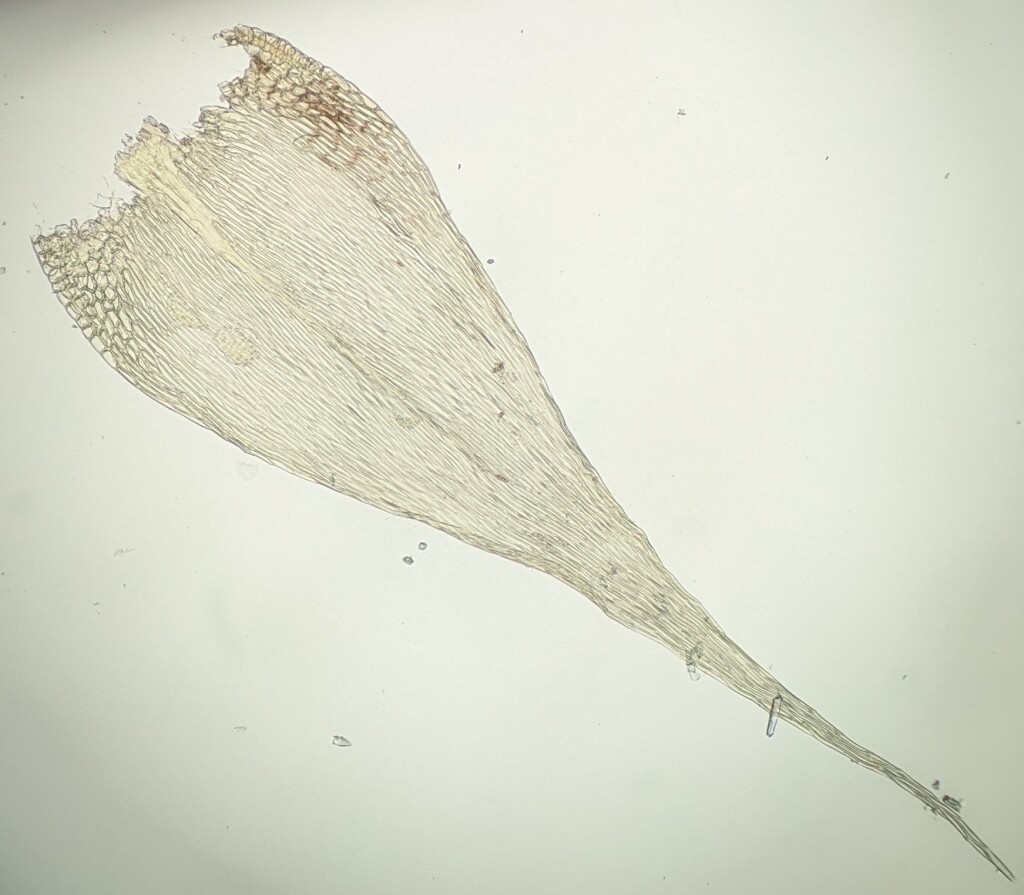Brachytheciaceae
Autoicous, dioicous, phyllodioicous (not in Victoria), polyoicous (not in Victoria) or synoicous (not in Victoria). Asexual reproduction rarely by brood branches in clusters in axils of leaves near stem apex (not in Victoria). Loose to dense tufts or mats on soil, rocks, logs or trees. Stem creeping, ascending to erect or pendent (not in Victoria), irregularly, pinnately or bipinnately branched, with rhizoids ventrally where in contact with substrate or in fascicles below leaf insertion; paraphyllia absent or rarely present as longitudinal ridges; pseudoparaphyllia present, foliose, first pointing downwards and the other two situated at 120 ˚ to the first; central strand present or rarely absent (not in Victoria). Leaves arranged around stem and facing all directions or complanate, monomorphic or those of stems and branches differentiated, often imbricate, sometimes falcate-secund, erect to squarrose when moist, scarcely altered, twisted, or becoming appressed (not in Victoria) or more erect when dry, often plicate, usually decurrent; apex rounded and apiculate, obtuse, acute or acuminate, occasionally piliferous; costa single, terminating in basal half to apical half, or rarely absent (not in Victoria), short and double, percurrent (not in Victoria) or shortly excurrent (not in Victoria), with or without a terminal spine; margin entire to serrate, plane or recurved, without a border; laminal cells linear, rhombic, ovate (not in Victoria) or round (not in Victoria), smooth or prorate; alar cells indistinctly or well differentiated, quadrate to elongate, sometimes inflated. Pleurocarpous. Seta rough or smooth. Capsule erect (not in Victoria) to pendent, immersed (not in Victoria) or exserted, operculate, without an annulus (not in Victoria) or annulus present and usually separating by fragments. Calyptra cucullate or rarely mitrate (not in Victoria), glabrous or hairy. Operculum conic or rostrate. Peristome double and alternate; exostome of 16 entire teeth; endostome with 16 distinct segments, or segments adherent to exostome (not in Victoria) or lacking (not in Victoria), with a low to high basal; cilia present or absent.
Worldwide, with around 44 genera and 250 species; nine genera and 18 species in Victoria.
The Brachytheciaceae are morphologically distinguished from all other families by a combination of the arrangement of the pseudoparaphyllia, whereby the first to develop points downwards and the other two are situated at 120 ˚ to the first, and laminal cells that are smooth or prorate (Ignatov & Huttanen 2002; Huttanen & Ignatov 2004). As such they are one of the most well-defined large families of pleurocarpous mosses (Huttanen & Ignatov 2004). Most species, including all in Victoria, can also be distinguished from many other pleurocarpous mosses by the presence of a single costa.
In contrast to vascular plants that include a significant proportion of introduced species in Australia (around 12.2 %), only approximately 24 species of moss have been putatively introduced during European occupancy to Australia and of these species seven belong to the Brachytheciaceae, five of which have been recorded in Victoria (Dell 2020). This includes Pseudoscleropodium purum (Hedw.) M.Fleisch., which is highly invasive and a threat to natural moist environments in Victoria (Milne & Jolley 2010; Dell 2020), and has invaded the second most regions globally of any moss species (Essl et al. 2013).
 Spinning
SpinningDell, M. (2020). Bryophytes as weeds in Australia. The Victorian Naturalist 137: 179–194.
Essl, F.; Steinbauer, K.; Dullinger, S.; Mang, T.; Moser, D. (2013). Telling a different story: A global assessment of bryophyte invasions. Biological Invasions 15: 1933–1946.
Huttunen, S.; Ignatov, M.S. (2004). Phylogeny of the Brachytheciaceae (Bryophyta) based on morphology and sequence level data. Cladistics 20: 151–183.
Ignatov, M.S.; Huttunen, S. (2002). Brachytheciaceae (Bryophyta) – a family of sibling genera. Arctoa 11: 245–296.
Milne, J.; Jolley, H.M. (2010). The importance of herbarium records in documenting the occurrence and changing distribution of the adventive moss species Pseudoscleropodium purum in Victoria. The Victorian Naturalist 127: 146–150.



